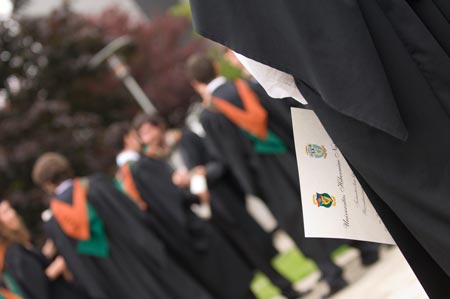UCD Science & Engineering in Belfield
Upon moving to Belfield in 1964, UCD’s faculty of science was located in some of the old estate houses as well as the new science building, and a small number of teaching and research facilities remain to this day in the nineteenth century Ardmore House. One by one, new buildings sprang up on campus, with the engineering building opened in 1989. Civil and agricultural (later biosystems) engineering remained in the city centre until UCD’s long presence in Earlsfort Terrace came to an end in 2007. They did not move to an expanded engineering building as originally planned: civil engineering moved to the former Philips Electronics building in Clonskeagh, now known as Newstead and integrated with the Belfield campus, while biosystems engineering moved to the agriculture building.
Science and engineering in UCD, in common with the rest of the university, have seen increases in the number of undergraduate and postgraduate students and an increasingly international student body. Degree programmes have developed significantly, with greater flexibility, opportunities to study abroad or spend periods in industry, and an enhanced interface with research and innovation. The desire for research activities at a scale that can compete globally, coupled with the increased availability of research funding from national, European and other sources, has seen the development of large and often multi-disciplinary research institutes and centres on campus, such as the Conway Institute for Biomolecular and Biomedical Research.
UCD engineers and scientists continue to apply their research to solve problems faced by Irish industry and to realise entrepreneurial opportunities. A BSE test using technology developed in UCD and licensed to Irish company Enfer Scientific has sold millions of test kits, and came at a time when the disease threatened to devastate the Irish livestock export trade. The Electricity Research Centre, which was founded in partnership with EirGrid and ESB and now partners with over 30 companies around the world, has been a major contributor to Ireland’s success in the integration of renewables onto the electricity grid. A number of companies have grown out of research conducted in UCD science and engineering in recent years, including Intune Networks (optical networking), ChangingWorlds (personalisation software), Celtic Catalysts (chemistry) and BiancaMed (medical technology). Most recently, the National Institute for Bioprocessing Research and Training (NIBRT) has opened a state-of-the-art training and research facility at Belfield to support the development of the bioprocessing industry in Ireland and to attract additional bioprocessing companies to the country.
In 2007, when UCD’s long move to Belfield from its city centre facilities was finally completed, the science building was almost fifty years old and under stress in the face of greatly expanded student numbers and new ambitions for teaching and research. Today, once again, the science building is at the centre of building activity in Belfield. In a multi-phase project that will renovate and expand the existing facilities, a new science centre will provide over 30,000 square metres of dedicated teaching and research space. At the same time, a refinement of academic structures will create a College of Science, as well as a College of Engineering and Architecture, within UCD, the title evoking memories of a distinguished predecessor.




